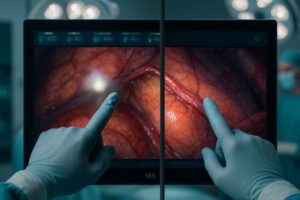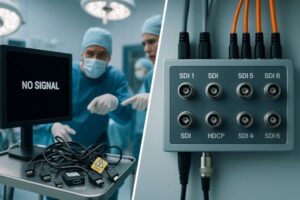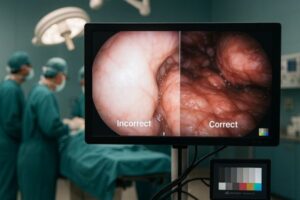Radiologists face challenges with image clarity on standard screens, risking diagnostic accuracy. This ambiguity can affect patient care. Medical monitors are designed to deliver the necessary precision for confident interpretations.
Medical monitors serve PACS rooms by offering superior image quality, consistent DICOM-compliant displays, and features that boost diagnostic accuracy. They improve workflow efficiency, crucial for handling complex radiological studies.
Discover how these advanced displays are revolutionizing the modern radiology reading room.

What display specifications are required for PACS image reading?
Generic screens can obscure vital details in medical images. This compromises diagnostic confidence. Specific display specifications are thus non-negotiable for accurate PACS reading.
PACS image reading demands high resolution, excellent contrast, precise grayscale fidelity, and uniform luminance. These are foundational for clear visualization of medical images.
The demands of a modern PACS reading room necessitate display technology that goes far beyond standard office monitors. From my experience, several key specifications are absolutely critical. High resolution is paramount; we offer displays ranging from 1MP like our MD10C for basic review up to 12MP with our MD120C for intricate studies like mammography. This range ensures that every pixel holds vital diagnostic information. Equally important is a high contrast ratio, which allows for the discernment of subtle differences in tissue density. This is complemented by impeccable grayscale fidelity, a cornerstone of medical imaging. Our monitors are compliant with the DICOM Part 14 standard1, ensuring that grayscale images are rendered consistently and accurately, reflecting true tissue values. Furthermore, luminance uniformity2 across the entire screen prevents misinterpretation due to brighter or dimmer areas, a common issue with lesser displays. Wide viewing angles also contribute to a collaborative environment, allowing multiple professionals to view images accurately. These precise specifications are what differentiate a medical-grade display and underpin diagnostic confidence. As President of Reshin, with a background in surgical imaging systems, I’ve seen firsthand how critical these details are. Our dedication at Reshin is to advance this technology, making high-quality displays accessible to all medical professionals.
Key Display Specification Comparison
| Feature | Consumer Display | Reshin Medical Display (e.g., MD series) |
|---|---|---|
| Resolution | Typically HD/FHD | 1MP to 12MP (e.g., MD10C to MD120C) |
| DICOM Compliance | No | Yes, Part 14 Standard |
| Grayscale Fidelity | Variable, uncalibrated | High, factory calibrated |
| Luminance Stability | Fluctuates | Consistent, often with sensors |
| Regulatory Approval | General use | Medical certifications (CE, FDA, etc.) |
| Suitability for PACS | Low | High, designed for diagnostic use |
Our R&D team, exceeding 200 members, focuses intensely on these specifications, leveraging over a decade of individual experience. This expertise has resulted in over 100 technology patents and copyrights, ensuring Reshin displays like the MD22CA or MD32C meet the stringent demands of modern radiology.

How do medical monitors enhance diagnostic accuracy in PACS workflows?
Diagnostic errors due to poor image quality are a serious concern. This uncertainty impacts patient outcomes. Medical monitors directly address this by enhancing image clarity.
Medical displays boost accuracy by providing consistent, high-quality images across modalities. This reduces eye fatigue and helps radiologists detect subtle pathologies more effectively during long sessions.
Enhancing diagnostic accuracy is the primary goal of any imaging tool in a PACS workflow, and specialized medical monitors play a pivotal role. From what I’ve seen in practice, their impact is multifaceted. Unlike general-purpose monitors, our medical displays, such as the versatile 8MP Diagnostic Display3, are engineered to maintain stable and consistent image quality across various imaging modalities—be it MRI, CT, X-ray, or ultrasound. This consistency is crucial, as radiologists often compare studies from different sources. Features designed to reduce eye strain, like flicker-free backlights4 and blue light reduction, are standard in models like our MD50C for mammography or the MD51CHY for X-ray imaging. This allows professionals like Dr. Amy Chen, with her PhD in Biomedical Engineering and experience in image processing, to sustain focus and accuracy during extended reading sessions. The superior resolution and contrast5 inherent in these displays mean that subtle anatomical details and pathological indicators are more clearly visualized, directly contributing to more confident and accurate diagnoses. Furthermore, many of our displays offer rapid image loading and intuitive controls, streamlining the workflow and allowing radiologists to dedicate more time to interpretation rather than system management. Our commitment to advancing medical display technology is reflected in our skilled R&D team and over 100 technology patents, and trusted by global brands like Philips and Fujifilm.

Why is DICOM calibration crucial in PACS reading rooms?
Inconsistent displays can lead to diagnostic variability. This compromises patient safety. DICOM calibration standardizes image presentation, ensuring reliable interpretations across devices.
DICOM calibration is vital because it ensures images are displayed consistently, as intended by the imaging device, aligning grayscale values with human perception for accuracy.
The term ‘DICOM calibration6‘ frequently comes up in discussions about medical displays, and for good reason. It’s not merely a technical jargon; it’s a cornerstone of diagnostic reliability in PACS environments7. DICOM (Digital Imaging and Communications in Medicine) Part 14 is a global standard that dictates how grayscale medical images should be displayed to match human visual perception. In essence, it ensures that a specific shade of gray represents the same tissue density, regardless of which DICOM-calibrated monitor it’s viewed on. This standardization is critical. I’ve seen how it directly improves the detection of subtle lesions in applications like chest X-rays, where a faint opacity might be missed on an uncalibrated screen, or in neuroimaging, where minute changes can signify serious conditions. All Reshin MD-series diagnostic monitors8, including models like the MD26GA or the MD33G, undergo rigorous DICOM calibration. This ensures that when a radiologist views an image, they are seeing it as the acquiring modality intended, leading to greater diagnostic confidence and consistency. This is particularly important in institutions like Dr. Chen’s, where precision is paramount for diverse surgical and diagnostic needs. This dedication to quality makes Reshin a trusted name, serving over 100,000 hospitals worldwide.

How does ambient lighting control relate to monitor performance in radiology?
Room lighting significantly impacts image perception on screens. Uncontrolled light can obscure details, leading to misinterpretation. Managing ambient light is key for optimal viewing.
Optimal monitor performance in radiology needs controlled, low ambient lighting. This minimizes glare and reflections, ensuring the display’s full dynamic range is clearly perceptible.
The environment in which a radiologist works is almost as critical as the tools they use. In my experience, ambient lighting9 in a PACS reading room must be carefully controlled to optimize monitor performance. Radiology reading rooms are typically kept quite dim, and this isn’t just for atmosphere. Low ambient lighting, usually between 20-50 lux, is recommended to minimize screen glare and reflections, which can wash out image contrast and obscure subtle details. If the room is too bright, the perceived dynamic range of the monitor is reduced. Our Reshin monitors, such as the MD26C or the MD32C, often feature anti-glare screen surfaces10 to combat this. Furthermore, since PACS rooms use low ambient lighting, our displays incorporate features like luminance stabilization11. This technology ensures that the monitor’s brightness remains constant over time and across different operating temperatures. Some models in our advanced diagnostic range, such as the MD120C with AI calibration, also include intelligent backlight sensors or auto-brightness features that can subtly adjust to minor changes in ambient light, always maintaining consistent and optimal viewing conditions. This attention to the interplay between the display and its environment is crucial for sustained diagnostic accuracy, a principle deeply embedded in Reshin’s design philosophy.

How does Reshin optimize display design for PACS applications?
Radiologists need displays tailored for their intense work. Generic monitors often lack specific, crucial features. Reshin designs its monitors specifically for PACS environments.
Reshin optimizes displays for PACS with high resolution, strict DICOM calibration, ergonomic designs, and multi-modality support, ensuring diagnostic confidence and user comfort for radiologists.
At Reshin, we understand that a PACS reading room is a high-stakes environment where professionals like Dr. Chen demand precision. That’s why our MD-series radiology monitors, from the 1MP MD10C to the advanced 12MP MD120C, are meticulously designed to meet these specific demands. Our optimization strategy is built on several pillars. Firstly, strict adherence to DICOM Part 14 calibration12 ensures consistent and accurate image representation. This is non-negotiable. Secondly, we offer a range of resolutions and specialized displays, like the MD50C Color Mammography Monitor or the MD52G Grayscale Mammography Monitor, tailored for specific diagnostic tasks. For enhanced workflow, models like the MD45C and MD46C dual-screen single-panel displays offer KVM control and multiple input ports, allowing radiologists to manage different sources efficiently. We also prioritize user well-being. Features such as blue light filtering13 and flicker-free technology reduce eye strain during long reading sessions, complemented by ergonomic designs14 with adjustable height, tilt, and swivel. Our extensive R&D, backed by over 100 technology patents, ensures that Reshin monitors provide a reliable, precise, and comprehensive solution for any high-demand PACS environment, supporting the critical work in over 100,000 hospitals worldwide, as recognized even by President Xi Jinping in 2018 for our surgical displays.

Conclusion
Medical monitors are truly indispensable for modern PACS reading rooms. Reshin is committed to providing optimized display solutions that enhance diagnostic accuracy and streamline radiological workflows. To equip your PACS environment with purpose-built diagnostic monitors, contact Reshin at martin@reshinmonitors.com.
-
The DICOM Part 14 standard ensures image consistency in medical imaging. Discover its significance for accurate diagnostics. ↩
-
Luminance uniformity is vital for accurate image interpretation in medical displays. Learn more about its impact on diagnostics. ↩
-
Explore how the 8MP Diagnostic Display enhances diagnostic accuracy and image quality in medical imaging workflows. ↩
-
Learn about the importance of flicker-free backlights in reducing eye strain for radiologists during long reading sessions. ↩
-
Discover how superior resolution and contrast in medical displays lead to better visualization of anatomical details and improved diagnoses. ↩
-
Understanding DICOM calibration is essential for ensuring accurate medical image interpretation, which can significantly impact patient care. ↩
-
Exploring PACS environments will provide insights into how they enhance the efficiency and reliability of medical imaging systems. ↩
-
Discovering the best diagnostic monitors can help healthcare professionals choose the right tools for accurate image analysis and patient diagnosis. ↩
-
Understanding the role of ambient lighting can enhance your knowledge of optimal radiology environments, improving diagnostic accuracy. ↩
-
Learning about anti-glare technology can help you appreciate how it improves visibility and reduces eye strain in medical imaging. ↩
-
Exploring luminance stabilization will provide insights into how monitor technology enhances image quality and consistency in diagnostics. ↩
-
Understanding DICOM Part 14 calibration is crucial for ensuring accurate image representation in radiology, enhancing diagnostic precision. ↩
-
Exploring blue light filtering technology can reveal its benefits in reducing eye strain, crucial for radiologists during long reading sessions. ↩
-
Discovering the advantages of ergonomic designs can help improve comfort and efficiency for medical professionals in high-stakes environments. ↩



